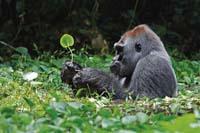The microorganism responsible for malaria can come from gorillas

The origin of the malaria microorganism can be in gorillas and not chimpanzees, as previously thought. At least researchers from the University of Alabama in the US have reached this conclusion. It has been published in the journal Nature.
The microorganism Plasmodium falciparum is responsible for most types of malaria in humans and is transmitted by the bite of the mosquito Anopheles gambiae. But so far it was not very clear what the origin of evil was.
As a clarification, DNA studies have been conducted with nearly 3,000 excrement samples collected in wild populations of chimpanzees, bonobos and gorillas (sub-Saharan Africa) to detect the DNA of Plasmodium. It has been explained that the Plasmodium detected in samples of gorillas of the west of the continent (Gorilla gorilla) are those that have greater similarity with those observed in humans. And so they have come to the conclusion that in this species may be the origin of malaria. The parasite would pass from the Western gorillas to man, and not from the chimpanzees to man, as previously thought. In addition, researchers believe that this transmission between species was probably done in a single step, directly.
For its part, the National Institute of Allergy and Infectious Diseasess of Maryland has observed in another study the immune system of the Anopheles mosquito. The mosquito transmits the disease, but for this the insect itself must be immune. And that's what they've researched, how the mosquito is immunized.
It seems that granulocytes are responsible for this: the researchers observed that the number of granulocytes is three times higher in immunized mosquitoes. Granulocytes are immune system cells that are attacked by the detection of a foreign cell in the insect's blood.
This number of granulocytes, however, requires prior contact with the malaria microorganism. In fact, Plasmodium weakens the walls of the intestine and intestinal bacteria cross the wall. This favors the formation of more granulocytes that are more resistant to the parasite.
Buletina
Bidali zure helbide elektronikoa eta jaso asteroko buletina zure sarrera-ontzian











